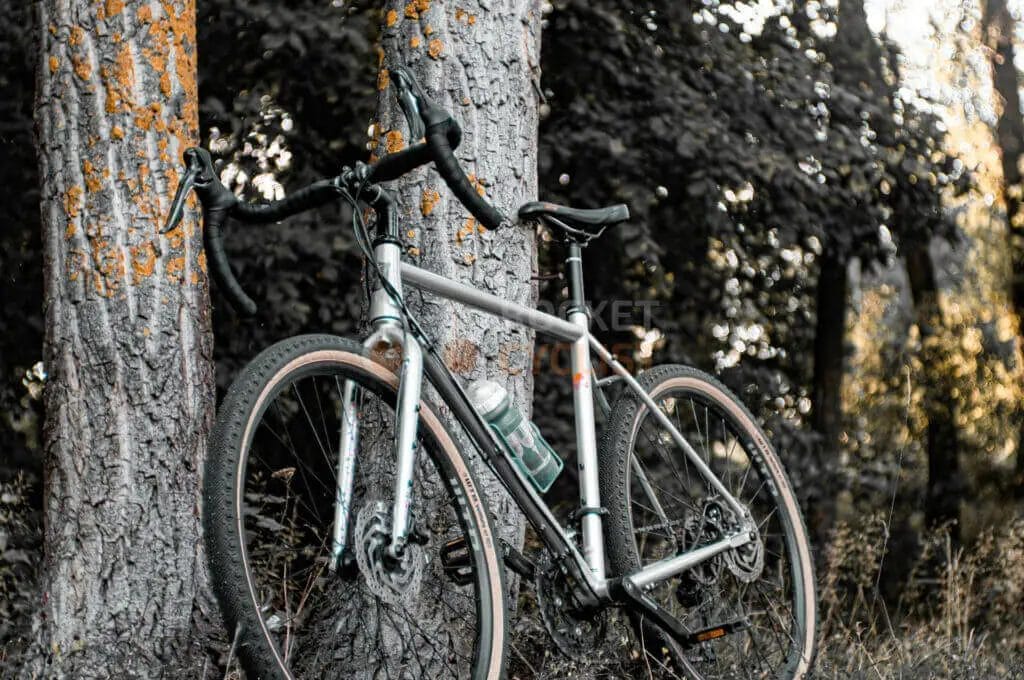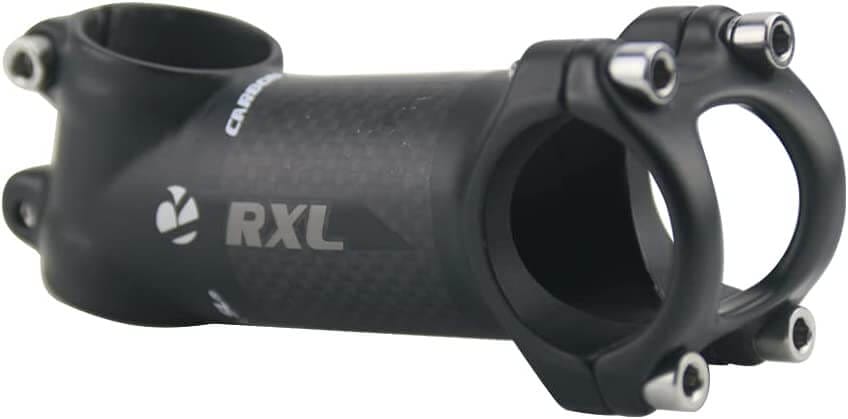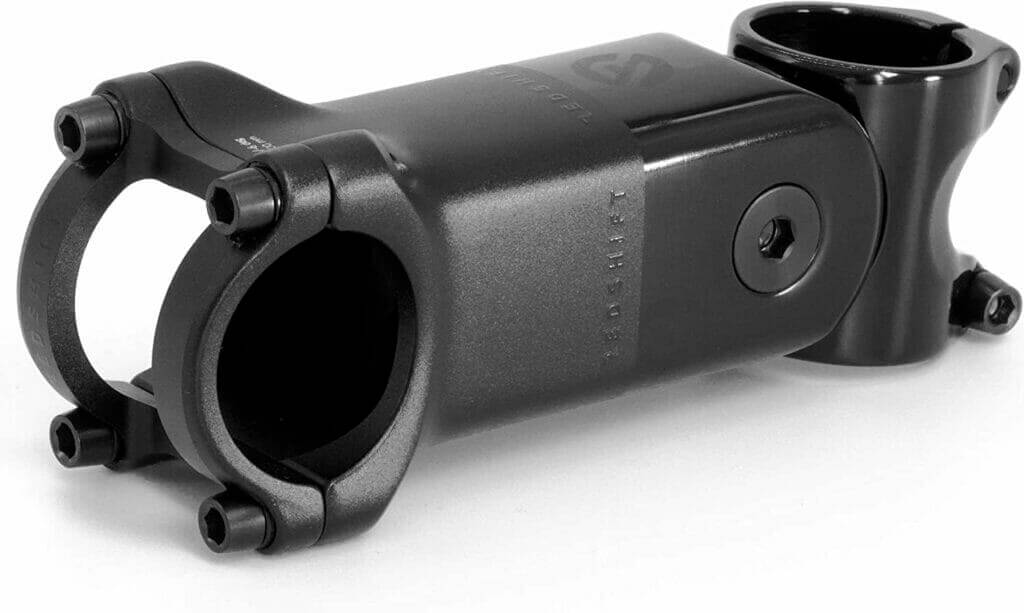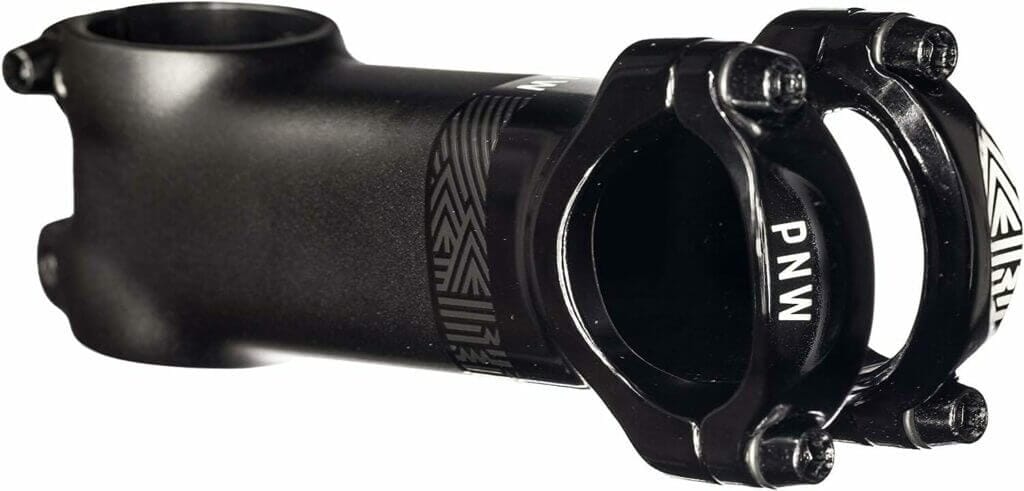Last Updated on March 23, 2024 by Vinson Lozano

When it comes to gravel biking, the right stem angle and length can make a significant difference in your riding experience. The stem is the component that connects the handlebars to the fork steerer tube, and its angle and length play a crucial role in determining your bike’s handling, comfort, and overall performance on diverse terrain.
In this blog article, we will explore the importance of finding the optimal stem angle and length for your gravel bike. Whether you’re a seasoned gravel rider or new to the sport, understanding how these variables impact your bike’s fit and handling is essential.
We will delve into the factors to consider when selecting the right stem, such as your riding style, body position, and personal preferences. Additionally, we’ll provide practical tips on how to measure and adjust stem angle and length to achieve the perfect setup for your gravel adventures.
So, if you’re eager to enhance your gravel biking experience and fine-tune your bike’s performance, let’s dive in and discover the world of gravel bike stem angles and lengths.
Overview of Gravel Bike Stems
As you immerse yourself in this genre of cycling, upgrading and enhancing your gravel bike becomes key to making the most out of your wild rides.
One bike component that holds the ability to transform your experience is the gravel bike stem. We’re here to discuss all the ins and outs of this essential piece, and help you reach peak performance while navigating the rough and rugged landscapes ahead.

When it comes to gravel biking, finding the perfect stem is crucial for enjoying your off-road adventure. The stem connects your handlebars to your bike’s forks, influencing how responsive and stable your bike feels over rough terrain.
Gravel Bike Stem Size
First, let’s talk about stem size. Gravel bike stems typically range from 60-100mm in length, sitting between road bike stems which are usually 90-120mm long, and mountain bike stems which are around 50-80mm long. The ideal stem length depends on your bike’s geometry, your riding style, gravel roads, and your comfort preferences.
Shorter stems provide quicker handling, making them great for navigating tight turns and technical sections. However, if you opt for a shorter stem, make sure your bike’s geometry accommodates this choice, as it can affect your overall reach and position on the bike.
Longer stems offer more stability at high speeds and on rough terrain, with slower but more predictable handling. If you prefer a more aggressive riding style or cover long distances on your gravel bike, a longer stem may be better suited for your needs.
Remember, making any changes to your stem length can affect other aspects of your bike fit, such as knee tracking and back, neck, and shoulder muscles.
It’s important to consider how these changes might impact your overall comfort and performance before making a decision. A professional bike fit can help you find the perfect stem length and angles, ensuring an enjoyable and comfortable gravel biking experience.
Stem Length and Rise/Drop
Gravel biking is an adventure that combines the best of road and off-road cycling. To tailor your gravel biking experience to your unique riding style and preferences, it’s essential to focus on the often-overlooked detail of your bike’s stem length and rise/drop.
Choosing the right stem length and angle can significantly impact your bike’s handling, fit, and overall performance.
Stem angle, also known as rise/drop comes in various angles, and by flipping them, you can adjust the bike’s stack height, which affects your riding position. A positive rise stem will raise your handlebars and provide more upright, relaxed riding.
Conversely, a negative drop stem will lower your handlebars and position you more aggressively. This adjustment is particularly essential for gravel biking, where varied terrain and riding styles can significantly influence your preferred stack height.
In summary, paying close attention to your gravel bike’s stem length and rise/drop is essential to optimize its handling, fit, and performance. Don’t be afraid to experiment with different configurations to find the perfect balance between stability, agility, and comfort that best suits your unique riding preferences. Happy gravel biking!
Stem Diameter

When it comes to gravel bikes, one component that plays a crucial role in the overall performance is the stem diameter. The stem connects the handlebars to the fork steerer tube, and its diameter determines the compatibility with various accessories and components. Stem diameter can usually be categorized as either 31.8mm or 35mm, with each size offering its own advantages and considerations.
The stem diameter is important because it affects the compatibility with handlebars and accessories. A 31.8mm stem diameter is the standard size found on many road bikes, making it a popular choice for gravel bikes as well. This diameter allows for a wide range of handlebar choices, making it easy to adjust the bike’s fit to your preference. Additionally, it provides compatibility with various components like computer mounts and light brackets.
On the other hand, 35mm stem diameter is gaining popularity in the gravel riding scene. This wider diameter offers increased stiffness, which can enhance control and stability on rough terrains. It also allows for a cleaner and more integrated look with some handlebar designs. However, it’s important to note that 35mm handlebars and accessories are not as widely available as their 31.8mm counterparts.
Choosing the right stem diameter for your gravel bike depends on your riding style, preferences, and component compatibility. If you value the versatility of handlebar choices and easy compatibility with a wide range of accessories, a 31.8mm stem diameter might be the ideal option. On the other hand, if you prioritize increased stiffness and prefer a cleaner, integrated look with limited component options, a 35mm stem diameter could be the right choice for you.
The impact of stem diameter on gravel riding can be significant. A properly chosen stem diameter can ensure a comfortable fit, allowing you to spend more time riding and exploring without fatigue or discomfort. It can also contribute to the overall handling and control of your bike, making it more responsive and stable on various terrains.
In summary, selecting the right stem diameter is an important consideration for gravel riders. Whether it’s the versatility of a 31.8mm stem or the increased stiffness of a 35mm stem, finding the right balance between compatibility, comfort, and control is essential. So, take the time to understand your preferences and consult with experts to make an informed decision that enhances your gravel riding experience.
Construction Materials of Stems
As you start searching for the perfect stem for your bike, it’s essential to consider the construction material for the best performance and durability.
Generally, gravel bike stems are made from two primary materials: aluminum alloy and carbon fiber.
Aluminum stems are known for their strength and durability, making them ideal for withstanding the challenges of off-road riding. They are budget-friendly and offer a touch of extra weight, which is often a negligible trade-off for enhanced performance and longevity.
On the other hand, carbon fiber stems are lightweight and provide a sleek, modern appearance to your bike. These stems are perfect for those looking to shave off some grams from their bike’s overall weight while maintaining excellent handling capabilities. However, it’s essential to keep in mind that carbon stems come with a higher price tag compared to their aluminum counterparts.

RXL SL Stem 31.8 Carbon Fiber Handlebar Stem 6 Degree -60/70/80/90/100/110/120mm
In summary, choosing the right construction material for your gravel bike stem significantly affects your bike’s performance, handling, and fit. Whether you opt for an aluminum alloy or carbon fiber stem, make sure to take into account your budget, weight preferences, and riding conditions to make the best decision for your gravel bike adventures.
Handlebar Clamp Diameter
Choosing the right handlebar clamp diameter for your gravel bike stem is crucial for both comfort and performance on your rides. It’s essential to find the perfect fit to ensure a secure attachment between your bike’s handlebars and the stem.
In this section, we’ll guide you through the process of determining the best handlebar clamp diameter for your gravel bike stem.
To start, you need to be familiar with the different handlebar clamp diameter options available in the market. The most common sizes are 25.4mm, 26.0mm, and 31.8mm. These sizes cater to varying types of bike stems and handlebars, so it’s important to know which one suits your specific needs.
Before you make a decision, take a moment to assess your current riding style and preferences. If you often cycle on rough terrain or need a more robust handlebar clamp diameter for added stability, the 31.8mm option might be the best choice for you. This size is widely used in both road and mountain biking, making it suitable for gravel bikes as well.
On the other hand, if you prefer a slightly more relaxed riding position and require less stiffness, the 25.4mm or 26.0mm handlebar clamp diameter might be a better option. These sizes are more common for recreational and vintage bikes, offering a comfortable grip and ensuring compatibility with various handlebar styles.
After determining the appropriate handlebar clamp diameter for your gravel bike stem, it’s essential to check for compatibility with your bike’s steerer tube diameter and handlebars. Furthermore, consider the material, length, and rise or drop of the stem to achieve your desired bike fit and performance.
In summary, finding the perfect handlebar clamp diameter for your gravel bike stem is a crucial step towards achieving a comfortable, efficient, and enjoyable cycling experience. Remember to consider your personal preferences, riding style, and bike compatibility when making your decision.
Gravel Bike Stem vs Road Bike, Mountain Bike, Cyclocross Bike Stems

Bike stems are an integral part of any bicycle, connecting the handlebars to the fork steerer tube. They play a crucial role in determining the rider’s position, comfort, and bike handling. However, not all stems are created equal, as different types of bikes require stems with specific characteristics to optimize performance.
In this section, we will explore the differences between bike stems for gravel bikes, road bikes, mountain bikes, and cyclocross bikes. Understanding these distinctions will help riders choose the right stem for their specific cycling needs.
1. Gravel Bike Stems:
Gravel bikes have gained immense popularity in recent years, offering a versatile and adventurous riding experience. Gravel bike stems typically feature a shorter length and a steeper angle compared to road bike stems. This setup promotes a more upright and comfortable riding position, enhancing control and stability on uneven surfaces. The shorter length also allows for better maneuverability when navigating tight turns and technical terrain.
2. Road Bike Stems:
Road bikes are designed for speed and efficiency on paved roads. Road bike stems tend to have a longer length and a shallower angle, promoting a more aggressive and aerodynamic riding position. This setup maximizes power transfer and reduces wind resistance. The longer stem also provides better stability at high speeds, making road bikes ideal for long-distance rides and racing.
3. Mountain Bike Stems:
Mountain bikes are built to tackle rough and challenging off-road trails. Mountain bike stems are typically shorter in length and have a steeper angle compared to both road and gravel bike stems. This setup allows riders to shift their weight back and maintain control when descending steep slopes. The shorter stem also provides quicker steering response, essential for navigating tight corners and technical terrain.
4. Cyclocross Bike Stems:
Cyclocross bikes are a hybrid between road and mountain bikes, designed for off-road racing with elements of road biking. Cyclocross bike stems often resemble road bike stems in terms of length and angle, promoting a more aggressive riding position. However, they may have additional features like more robust construction to withstand the demands of off-road racing. The versatility of cyclocross stems allows riders to adapt to various terrains encountered during races.
Choosing the right bike stem is crucial for optimizing performance, comfort, and control on different types of bikes. Gravel bike stems prioritize stability and maneuverability, road bike stems focus on aerodynamics and speed, mountain bike stems enhance control and responsiveness, while cyclocross bike stems offer a balance between road and off-road performance.
Understanding the differences between these stems will help riders make informed decisions based on their specific cycling needs. It is essential to consider factors like riding style, terrain, and personal preferences when selecting the ideal stem for your bike. Always consult with experts or bike professionals to ensure a proper fit and to make the most out of your cycling experience.
Popular Stem Brands
Are you searching for the perfect gravel bike stem to upgrade your gravel riding experience? Look no further, as we have gathered some popular stem brands that cater to your needs. With these reliable options, you’ll be sure to get the best combination of control, comfort, and performance while exploring those off-road trails.
CHROMAG Ranger V2 Stem

Introducing the Chromag Ranger V2 Stem, the perfect addition to your gravel or mountain bike setup. Designed with precision and crafted for durability, this stem will elevate your riding experience to new heights. Here are the key features of the Chromag Ranger V2 Stem:
- Material: Constructed from high-quality 7000-series aluminum, ensuring both strength and lightness.
- Length: Available in various lengths, allowing you to find the perfect fit for your bike and preferences.
- Rise: Choose from different rise options, letting you customize your bike’s handling and positioning.
- Clamp Diameter: The Ranger V2 Stem accommodates 31.8mm handlebars, making it compatible with a wide range of setups.
- Designed for Gravel Bikes: With a shorter length and slightly higher rise, this stem specifically caters to the needs of gravel bike riders.
- Enhanced Control: The Chromag Ranger V2 Stem delivers precise steering control and stability, enhancing your overall riding experience.
- Durability: Built to withstand the rigors of off-road terrain, this stem is designed to last and provide long-lasting performance.
- Versatile: Whether you’re riding gravel roads or tackling mountain trails, the Ranger V2 Stem ensures consistent and reliable performance.
Offered at a competitive price, the Chromag Ranger V2 Stem combines exceptional functionality with a sleek design. It’s the ideal component for any gravel bike enthusiast looking to upgrade their setup. Elevate your ride and conquer any terrain with the Chromag Ranger
Ritchey 4-Axis Adjustable Aluminum Alloy Bike Stem

Introducing the Ritchey 4-Axis Adjustable Aluminum Alloy Bike Stem – the perfect accessory for both gravel and mountain bikes. This high-quality stem offers a range of features that guarantee optimal performance and durability.
Key Features:
- 3D-net shaped forged shaft: The stem is designed with a forged shaft that ensures strength and stability for off-road adventures.
- Adjustable stem angle: With an adjustable angle of +/- 55 degrees, you can easily find the perfect height and position for your ride.
- Stainless steel bolts: The stainless steel bar and steerer clamp bolts provide exceptional durability, making this stem reliable even in rough terrains.
- Sleek black finish: The stem is coated with Ritchey’s BB Black finish, giving it a modern and stylish appearance.
Variations and Pricing:
- The Ritchey 4-Axis Adjustable Aluminum Alloy Bike Stem is available in black color.
- The stem has a weight of 0.25 kilograms.
- The product dimensions are 1.25″W x 3.54″H.
Advantages for Gravel Bikes:
- Versatility: This stem is suitable for gravel bikes, allowing riders to tackle various terrains with ease.
- Customizable position: The adjustable stem angle enables riders to find the most comfortable riding position for long gravel rides.
- Durability: The stainless steel bolts ensure that the stem can withstand rugged gravel trails, providing long-lasting performance.
Pricing and versatility make the Ritchey 4-Axis Adjustable Aluminum Alloy Bike Stem an excellent choice for gravel bike enthusiasts. Its robust construction, adjustable angle, and sleek design make it an indispensable accessory for any off-road adventure.
Ritchey Classic C220 Stem

Ritchey WCS C220 73D Aluminum Alloy Bike Stem for Gravel/Road Bike/MTB/Adventure Bikes
Introducing the Ritchey WCS C220 73D Aluminum Alloy Bike Stem, designed specifically for gravel bikes. This stem provides a secure and reliable interface for your handlebars, allowing you to tackle rough terrains with ease.
Key Features:
- Quick and easy installation with a press-fit handlebar clamp interface and forward-facing hardware.
- The stem wraps a full 220-degrees over the handlebar, creating a secure and strong connection.
- Manufactured with forged 2014 aluminum, ensuring durability and reliability.
- Premium CroMo steel bolts for added strength and longevity.
- Features Ritchey’s sleek and modern Blatte finish.
Variations and Pricing:
- Size: 31.8mm clamp diameter
- Angle: 17 degrees
- Suitable for: mountain, road, cyclocross, gravel, and adventure bikes
Advantages for Gravel Bikes:
- Secure Interface: The stem’s design ensures a secure and tight connection between the handlebars and the bike, providing stability and control when navigating rough and uneven gravel terrain.
- Durable Construction: Manufactured with forged aluminum and premium CroMo steel bolts, this stem is built to withstand the demands of gravel riding, offering long-lasting durability.
- Lightweight: Despite its robust design, the Ritchey WCS C220 73D stem is lightweight, making it suitable for gravel bikes where weight reduction is often a priority.
- Sleek Appearance: The stem’s Blatte finish adds a touch of modernity and elegance to your gravel bike, enhancing its overall visual appeal.
Upgrade your gravel bike’s performance and aesthetics with the Ritchey WCS C220 73D Aluminum Alloy Bike Stem. Experience enhanced control, durability, and style on your adventurous rides.
ShockStop Suspension Stem

Introducing the ShockStop Suspension Stem, a game-changer for gravel bikes. This patented stem is designed to smooth out road imperfections, reducing fatigue and strain on your body. Whether you’re tackling local group rides or exploring rough gravel backroads, the Redshift ShockStop Stem will make your ride smoother, faster, and more comfortable.
Key Features:
- Reduces fatigue from bumps and vibrations, allowing you to go further and ride longer.
- Converts wasted energy from suspending your body into forward motion, enabling you to ride faster.
- Customizable suspension feel lets you float over obstacles and maintain control over rough terrain.
The ShockStop Stem is available in two angle options (+/-6 degrees and +30 degrees) to suit your riding style. It comes in various lengths (80mm, 90mm, 100mm, 110mm, and 120mm) and two steerer tube diameters (1 1/8″ and 1 1/4″). Additionally, it includes five swappable elastomers, allowing you to fine-tune the suspension to match your preferences.
Advantages for Gravel Bikes:
- Smoother and more comfortable ride over rough terrain.
- Reduced fatigue and strain, enabling you to tackle longer gravel routes.
- Improved control and stability on uneven surfaces.
- Customizable suspension feel to match your riding style.
Upgrade your gravel bike with the ShockStop Suspension Stem and experience the unparalleled comfort and performance it offers. Say goodbye to the jolts and bumps, and hello to a smoother and more enjoyable ride.
PNW Components The Coast Stem for MTB or Gravel

Introducing the PNW Components The Coast Stem, designed specifically for gravel bikes. This versatile stem features a detachable mount that is compatible with action cameras and various headlamp options. Made of durable aluminum, it ensures durability and reliability on your gravel adventures.
Key Features:
- Clamp – Standard for road, MTB, and gravel grinders
- 7° Rise – Provides an ideal body position for long rides
- Detachable Mount – Allows for easy attachment of action cameras or compatible lights
- Various Length Options – Choose from 60mm, 70mm, 80mm, 90mm, or 100mm lengths
- Lightweight – Weights range from 111g to 136g, depending on the length
Pricing:
The PNW Components The Coast Stem is priced at $69.00, offering excellent value for its quality and versatile features.
Advantages for Gravel Bikes:
- Compatibility: The stem is specifically designed to fit gravel bikes, ensuring a seamless integration into your ride.
- Versatility: With the detachable mount, you can easily attach your action camera or compatible headlamp for recording your adventures or enhancing visibility during night rides.
- Comfort: The 7° rise provides an ergonomic body position, promoting comfort during long rides on uneven terrains.
- Durability: Constructed from high-quality aluminum, this stem is built to withstand the rigors of gravel riding, offering long-lasting performance.
Don’t compromise on your bike’s performance and upgrade to one of these popular brands to elevate your gravel riding experience. Soon enough, you’ll notice the difference a well-designed stem can make.
Installation of Stems
Installing a new stem on your gravel bike can significantly improve your riding comfort and overall performance. To begin the process, first gather the necessary tools like hex wrenches, and a torque wrench if you have carbon components.
Before you start, take note of your current stem position, height, and angle to make it easier to adjust or change your stem. First, loosen the bolts on the stem faceplate, which holds the handlebar in place. Carefully remove the faceplate and set it aside. Now, you can remove the handlebar from the stem.

Wake 31.8 90mm 110mm 0 60 Degree Adjustable Bike Stem
Next, loosen the pinch bolts on the steerer tube clamp, which connects the stem to the fork’s steerer tube. Gently slide the stem off the steerer tube and replace it with your new stem of choice. You may need to adjust the steerer tube spacers to achieve your desired stem height, so make sure to have some on hand.
Once your new stem is in place, reattach the handlebar to the faceplate and tighten the bolts using a hex wrench or torque wrench, as needed. It’s crucial not to over-tighten the bolts, as this can cause damage to your bike components.
Finally, make sure to test your new gravel bike stem setup by taking a short ride. If needed, make any necessary adjustments to fine-tune your handlebar height and reach for optimal comfort and performance. Happy riding!
Choosing the Right Stem for Your Riding Style.
When looking to upgrade or fine-tune your gravel bike, paying attention to your stem choice is essential in adjusting your riding position and handling. The stem is a crucial component that connects your handlebars to the fork’s steerer tube, thus influencing your overall comfort and control on the bike. With a variety of lengths and materials available, it’s vital to choose the right stem that best suits your riding style.
Begin by considering the stem length, as it affects both the handling of your bike and the reach from the saddle to the handlebar. Gravel bike stems typically fall somewhere between mountain bike stems (50-80mm) and road bike stems (80-120mm or longer). When choosing the stem length, keep in mind that a shorter stem results in more responsive handling while a longer stem leads to a more stable and predictable ride.
Next, assess your current ride position and comfort on your bike. A professional bike fit will help determine whether you need to make adjustments to relieve strain on your back, neck, or shoulders. Experiment with different stem lengths to find the perfect balance between comfort and performance, while also considering a slight bend in your elbows for better shock absorption.
Lastly, don’t overlook the stem material. Choose from options like aluminum, carbon fiber, or titanium based on your preferences for weight and stiffness, as well as compatibility with your handlebar and steerer tube. Remember, the right stem can make all the difference in enhancing your gravel riding experience, so take the time to find the one that fits your unique style and preferences.


